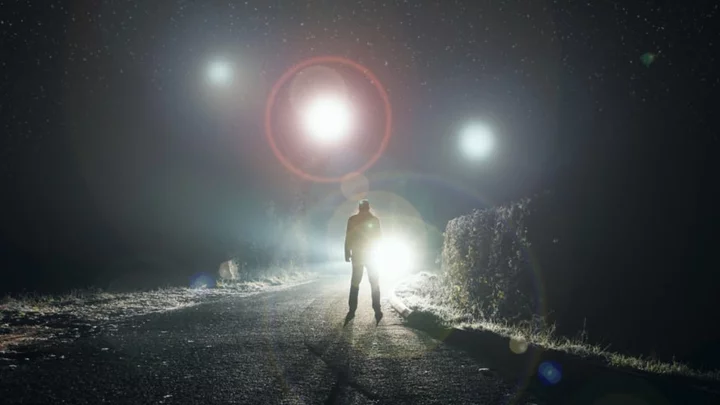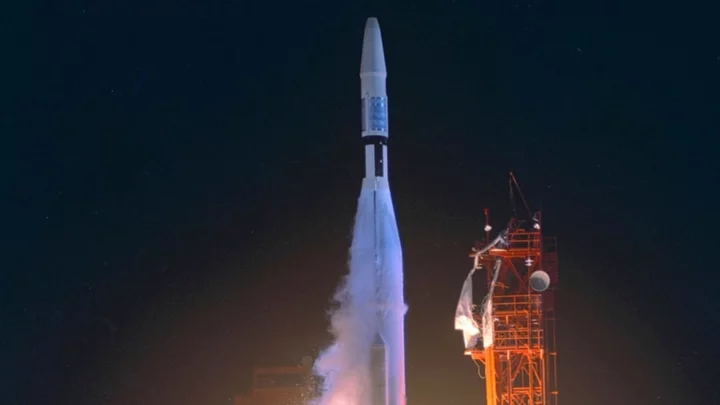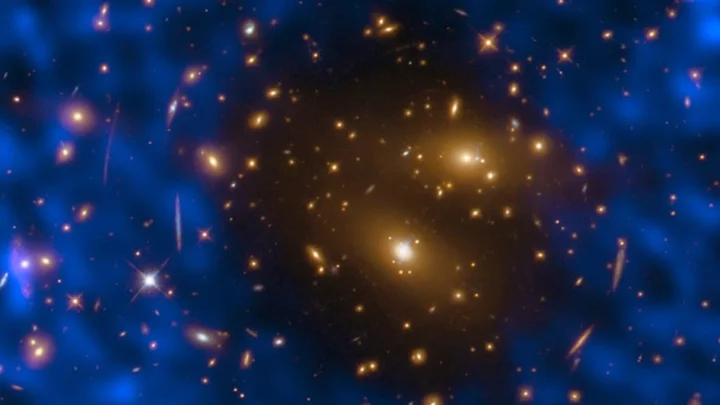
September Supermoon: When is it and how to view it?
The world is about to see the last Supermoon of the year. When the full Moon rises on 28 September, it will be bigger and perhaps brighter than usual, because it is relatively close to the Earth. Our nearest neighbour will be a mere 361,552km away. That compares with the average distance of 384,472km. Its relative proximity means that the Moon will appear larger and more clearly in the sky than usual, and can provide an exciting opportunity for people to get a good look at our satellite. Doing so is easier than with many other celestial phenomena: you can simply look up at the sky, and see whether you can spot the difference in the Moon’s size, though looking through telescopes or binoculars could provide a good look at its surface. It is best seen at Moonrise, when it begins to rise over the horizon. The other objects in front of it will help provide a sense of scale and can make the Moon look larger than normal. This month’s Moon is also known as the Harvest Moon, so named because it comes closest to the start of Autumn. As well as coming around harvest season, the bright reflections from the Moon can be a helpful way of working into the night. There is no formal definition of a Supermoon, and some astronomers have suggested that they are overhyped. What’s more, not all Supermoons are equal, and the lack of definition means that the word can be used for moons that are only slightly closer than normal. But they can bring significant increases in the amount of light that appears on Earth: Supermoons cast about 30 per cent more light than when the Moon is at its dimmest, according to the Natural History Museum. The museum’s planetary science researcher Sara Russell also noted that the Moon is actually moving slowly away from Earth. That means that what we call a Supermoon today was actually just the normal Moon a billion years ago. This year has been a busy one for fans of the Moon. Last month, for instance, also saw a supermoon – which also happened to collide with a Blue Moon, for the last time this decade. Read More MPs ask if Elon Musk ‘personally intervened’ on Russell Brand’s status on X Starship rocket launch window revealed by FAA India’s solar mission completes key manoeuvre, slingshots towards Sun
2023-09-21 18:23

NASA Is Finally Looking Into UFOs
The space agency now has an official division for investigating reports of flying objects.
2023-09-19 03:29

See an Annular Solar Eclipse Cast a “Ring of Fire” in October’s Sky
In October, catch this special type of solar eclipse that occurs only once every year or two.
2023-09-19 01:29

The Harvest Moon, the Final Super Moon of the Year, is Coming in Late September
The harvest moon is the full moon that falls closest to the fall equinox, and this year, it’s also a super moon.
2023-09-19 00:18

Nasa names new head of UFO research – after abuse forced space agency to try and keep them secret
Nasa has named its new head of research into unexplained phenomena spotted in the sky – after initially saying that it would not. The space agency said that its new head of research into Unidentified Anomalous Phenomena, or UAPs, would be kept secret in an attempt to keep them from being abused. Many of the publicly identified members its research panel have been subject to threats and harassment, the space agency has said. Previously, members of the panel said that abuse had kept them from properly examining the phenomena. The announcement of a new head of research came soon during the discussion of the panel’s first report into UFOs. That report said that it needed more scientific research to make firm conclusions – and less stigma and abuse of those doing it. During a panel discussion of that report, Nasa associate administrator Nicola Fox said that the space agency had appointed a new official to oversee the research and work with other federal agencies. But she told reporters that “we will not give his name out” for fear of reprisals. Later on Thursday, however, Nasa released a new blog post in which it identified the new director as Mark McInerney. “McInerney previously served as NASA’s liaison to the Department of Defense covering limited UAP activities for the agency,” it wrote. “In the director role, he will centralize communications, resources, and data analytical capabilities to establish a robust database for the evaluation of future UAP. “He also will leverage NASA’s expertise in artificial intelligence, machine learning, and space-based observation tools to support and enhance the broader government initiative on UAP.” The report did not give any indication of why the space agency had changed its mind on naming the new appointment. It only noted that it had made the decision to update it to “include details about the UAP research director”. In the 33-page report published earlier on Thursday, an independent team commissioned by NASA cautioned that the negative perception surrounding UFOs poses an obstacle to collecting data. But officials said NASA‘s involvement should help reduce the stigma around what it calls UAPs, or unidentified anomalous phenomena.“We want to shift the conversation about UAPs from sensationalism to science,” NASA Administrator Bill Nelson said. He promised an open and transparent approach. Officials stressed the panel found no evidence that UAPs had extraterrestrial origin. But Nelson acknowledged with billions of stars in billions of galaxies out there, another Earth could exist. “If you ask me, do I believe there’s life in a universe that is so vast that it’s hard for me to comprehend how big it is, my personal answer is yes,” Nelson said at a news conference. His own scientists put the likelihood of life on another Earth-like planet at “at least a trillion.” When pressed by reporters on whether the U.S. or other governments are hiding aliens or otherworldly spaceships, Nelson said: “Show me the evidence.” NASA has said it doesn’t actively search for unexplained sightings. But it operates a fleet of Earth-circling spacecraft that can help determine, for example, whether weather is behind a strange event. The 16-member panel noted that artificial intelligence and machine learning are essential for identifying rare occurrences, including UFOs. No top-secret files were accessed by the panel’s scientists, aviation and artificial intelligence experts, and retired NASA astronaut Scott Kelly, the first American to spend nearly a year in space. Instead, the group relied on unclassified data in an attempt to better understand unexplained sightings in the sky. Officials said there are so few high-quality observations that no scientific conclusions can be drawn. Most events can be attributed to planes, drones, balloons or weather conditions, said panel chairman David Spergel, president of the Simons Foundation, a scientific research group. The government refers to unexplained sightings as UAPs versus UFOs. NASA defines them as observations in the sky or elsewhere that cannot be readily identified or scientifically explained. The study was launched a year ago and cost under $100,000. Additional reporting by agencies Read More We cannot yet explain mysterious sightings in the sky, Nasa panel says Nasa boss says he believes in aliens during UFO hearings Watch as Nasa announces findings of long-awaited UFO study Nasa’s UFO study team reveals first ever report: as it happened Scientists might have seen a ‘life’ molecule on another planet SpaceX crew streak across sky before splashing down off Florida coast
2023-09-16 01:24

Nasa boss says he believes in aliens during UFO hearings
Nasa’s chief says he believes that aliens are real and waiting to be found. Bill Nelson was speaking after the publication of a report by a panel assembled to look into Unidentified Anomalous Phenomena (UAPs), the official names for UFOs, or unexplained objects spotted in the sky. That report found that while some UAPs remain unexplained, more data is found to understand where they have come from. Mr Nelson said that his “personal answer” is that there are vast numbers of inhabited planets throughout the universe. “With the James Webb [telescope] looking at the exoplanets, we are now beginning to discover, and somewhere out there we will discover, another medium-sized stony planet around a medium-sized sun or star at just the right distance... that has carbon, that will have a habitable atmosphere,” he said. “If you ask me do I believe there’s life in a universe that is so vast that it’s hard for me to comprehend how big it is, my personal answer is yes. But I asked some of our scientists: What is the mathematical probability that there is life out there in the universe? And if you calculate in billions of stars in billions of galaxies that there’s replicated in what I just said, another stony planet, the answer was ‘at least a trillion’. That’s from our scientists.” Read More Watch live: Nasa announces findings of long-awaited UFO study We cannot yet explain mysterious sightings in the sky, Nasa panel says Nasa’s UFO study team reveals first ever report: Live updates
2023-09-14 22:51

NASA panel calls for agency to play larger role in studying UFOs
By Joey Roulette WASHINGTON A NASA panel recommended in a report issued on Thursday that the U.S. space
2023-09-14 21:54

'Learning period' for US commercial space regulations should be extended -US Sen. Cruz
WASHINGTON A federal moratorium on commercial spaceflight safety regulations should be extended to support more innovation in the
2023-09-14 03:18

'It’s the biggest disappointment of our careers' Batgirl directors still devastated at movie's axing
'Batgirl' directors Adil El Arbi and Bilall Fallah are still devastated the movie was scrapped before being shown in theatres, and they are particularly disappointed that nobody could see Michael Keaton reprising his Batman role in their version.
2023-09-13 15:26

On This Day in 1962, NASA Launched and Destroyed Mariner 1
A software error coupled with a radar failure led to the loss of NASA's first Venus probe.
2023-09-12 00:50

8 Mind-Blowing Facts About the Big Bang
The birth of our universe happened at least 13 billion years ago—and you may have seen it on TV.
2023-09-12 00:23

Telesat taps SpaceX to launch its broadband satellites in orbit
By Steve Scherer OTTAWA Canada's Telesat on Monday said it has signed a agreement with SpaceX to launch
2023-09-11 19:28
